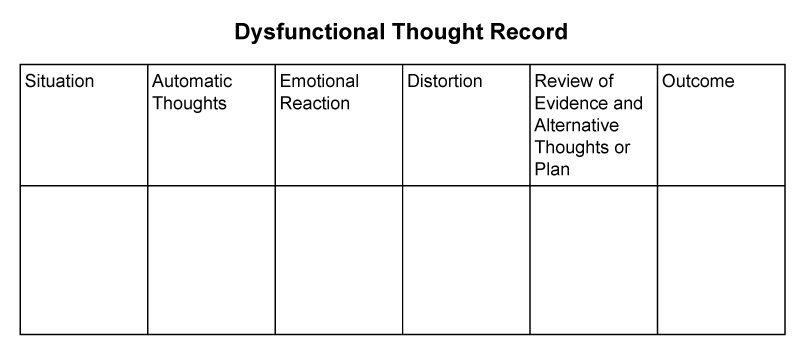Distortions
Many authors have described a number of distortions in automatic thoughts and often suggest that you identify them as a first step in learning to change them. To keep things simple, I have described just three distortions that I think represent the most common problems.
The first type of distortion is making predictions with out evidence. This often takes the form of “what if” thinking. People make predictions about things that are going to happen or problems that will arise and also predict the inability to deal with the problem. Developing an alternative for this type of distorted thought can include reviewing what evidence you do have to support the prediction.
The second type of distortion is thinking in absolutes. This may also be called black and white thinking and involve “should” statements. This can take the form of thinking “if something is not perfect it is no good”, or thinking I “should never” make mistakes.
The third type of distortion can be thought of as jumping to conclusions with out evidence. This distortion occurs when we do things like say “since I feel that way it must be true.” One of the most effective things to do when trying to develop alternatives for this type of distorted thought is review what evidence you have for the conclusion. Could you present this evidence to an objective judge and expect them to agree, or are you simply insisting it is true because you think it should be true?
You can use these directions and work on your own DTRs or thought records. You may want to look at the samples on this web site or at examples in one of the books by Dr. David Burns or my books.
View a DTR for checking on things
How to Use a Dysfunctional Thought Record (DTR)
To use the DTR, begin by writing a brief description of the events that have upset you or caused concern in the first column (Situation). This can be an external event such as something that happens to you, a conversation, or action of another person, coming into contact with a trigger for obsessions or a thought or image coming to mind. It may simply be thinking about something.

Next jump to the Emotional Reaction column and identify your emotional reaction to the situation. Rate how strong your emotional reaction is. I suggest using a scale of 0%-100%. The emotional response can be described in a few words. For example you might be describe your reaction as “fear” and rate it 90% and “sad” and rate it 50%.
Next go back to the Automatic Thought column note what is going through your mind that is causing you to be upset about the situation in the first column. This is often very difficult for people at first and you may need to practice this several times before it becomes comfortable.
In the Distortion column list what distortion you identify in the automatic thoughts. You can use distortions listed in David Burns’ book Feeling Good or use the simplified list of distortions described in my books and in the section below.
In the Review column write alternative thoughts about the event that do not have the distortions embedded in them. Review evidence that supports the automatic thought and the alternative you have come up with. Develop a plan for how to deal with the emotions and the thoughts about the situation.
In the Outcome column note what happens to the emotional reaction when the alternative thoughts are considered.